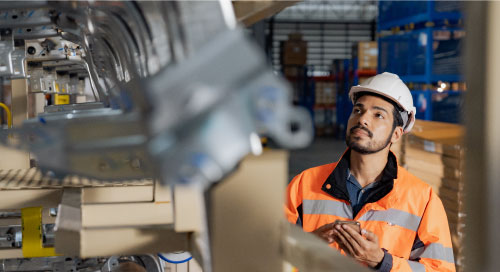Fill form to unlock content
Error - something went wrong!
Stay up to date with the latest IoT and network edge news.
Subscribed.
Applying Industrial AI Models to Product Quality Inspection

As a new car moves through the final stages of assembly, inspectors check every inch to spot any inconsistencies. Anything from chipped paint to wheel defects to irregular car engine sounds can tarnish the final product. Traditionally, these inspections are performed manually, but now workers can get much-needed assistance from artificial intelligence.
No matter how good an inspector is, humans miss details. Factory floors are noisy, busy places that can create distractions. Repeating the same tasks for hours can also cause the mind to wander, leading to errors. But this isn’t a problem for AI, which leverages cameras, microphones, and sensors in its unrelenting search for perfection on the assembly line.
“Visual inspection is really a tedious job. When you work in an industrial environment, your quality of work may degrade over time in a noisy environment. With AI, you can automate the process,” says Marcin Rojek, Cofounder of byteLAKE, the developer of Cognitive Services, a set of Industry 4.0-focused AI models that handle quality control.
The reason byteLAKE’s Cognitive Services exists is to deliver actionable information to operators that enables better decisions, says Rojek.
Unlike most industrial AI solutions, byteLAKE does more than just deal with visual improvements through computer vision. The company uses AI models for sound analysis and infrastructure monitoring. Leveraging microphones and other sensors, byteLAKE’s Cognitive Services can detect temperature, humidity, and vibrations to monitor equipment in efforts to optimize service delivery and prevent failures.
Cognitive Services Turns Data into Insights
When Rojek and his friend and business partner Mariusz Kolanko cofounded byteLAKE in 2016, they wanted to tackle the issue of what to do with all the data industrial organizations capture. Many struggle with just how to use it.
“We wanted to turn AI into a tangible solution for industrial cases. We combine the data and transform it into information, answering questions like, ‘What will happen, what will likely happen, why something happened, where’s the fault, what’s the error, and what’s the root cause?’” Rojek says.
This is possible by putting data from different sources in the proper context.
“Visual inspection is really a tedious job. When you work in an #industrial environment, your quality of work may degrade over time in a noisy environment. With #AI, you can automate the process” – Marcin Rojek, @byteLAKEGlobal via @insightdottech
In manufacturing, computer vision algorithms analyze and interpret images captured by cameras along the line. The models can be trained to understand certain images and detect things like scratches, dents, and missing holes, among other things.
In car manufacturing, microphones capture the pitch and roar of engines to determine if they run properly. It’s another area where human limitations can get in the way. “When you listen to tens of car engines in a factory facility with all the noise in the background, which is constantly changing, then your quality of inspection might degrade,” Rojek says.
And to ensure that all the information is collected in real time and stays at the factory level, the technology runs securely at the edge. This allows users to process the data close to where it is being produced, allowing them to overcome bandwidth and intermittent connectivity issues.
byteLAKE is also using computer vision in the food service industry to reduce wait times at self-serve restaurant checkouts. “The cashier doesn’t have to enter everything manually to the machine because the camera takes a picture and recognizes the items,” Rojek says.
In other environments, such as energy infrastructure, byteLAKE uses a combination of sensors, cameras, and microphones to track conditions such as liquid flow, humidity levels, pressure, and temperature—all of which provide information about the health and performance of pipes, pumps, drives, and other components. This helps optimize operations and resource utilization, reduce waste, and ultimately deliver better service.
“We can predict what will likely happen and suggest the optimal configuration of the energy management system for a whole city—where we need to plan in advance how much energy we should order within the next week based on current consumption, predicted consumption, historical data, weather forecasts, and so on,” says Rojek.
AI in Manufacturing Supplements Humans
While byteLAKE’s Cognitive Services are meant to replace repetitive, mundane, time-consuming, and error-prone tasks, Rojek views the solution as complementary to human work. Customers, he explains, don’t seem concerned about displacing humans because AI is solving problems such as workforce shortages. AI also contributes to worker safety. For instance, cameras and sensors allow humans to stand farther from perilous equipment on the assembly line.
byteLAKE also works with various partners on customer-specific solutions. Partners combine Cognitive Services with their own software and hardware automation to design workflows.
Existing models from previous implementations can be customized for new customers. For example, a paper mill model can be used in another plant by making adjustments for different lighting, production line dimensions, and other specifications.
Intel is an essential partner in making all of this happen. byteLAKE participates in programs such as AI Builders and leverages the OpenVINO™ toolkit to optimize its solutions and lower development costs.
Going forward, Cognitive Services will continue adding functionality. byteLAKE is working on models that learn on their own so they “can improve over time automatically.” In the near future, Rojek expects models will learn on the fly “to improve the quality of predictions as you progress and generate more data.”
Long term, the company will focus on easier integration with manufacturing software. “We don’t want to reinvent the wheel and we don’t want to change their processes too much on the manufacturing side. We want to supplement their operations and become part of their existing workflows rather than turn everything upside down,” Rojek explains.
This article was edited by Christina Cardoza, Associate Editorial Director for insight.tech.